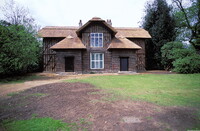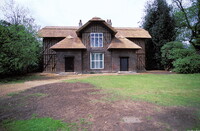| dc.coverage.spatial | Site: Kew (London, England, United Kingdom) | en_US |
| dc.coverage.temporal | begun 1759 (creation) | en_US |
| dc.creator | Brown, Capability | en_US |
| dc.creator | Chambers, William | en_US |
| dc.creator | Nesfield, William Andrews | en_US |
| dc.date | 1759-9999 | en_US |
| dc.date.accessioned | 2013-03-28T14:02:05Z | |
| dc.date.available | 2013-03-28T14:02:05Z | |
| dc.date.issued | 1759-9999 | en_US |
| dc.identifier | 203547 | en_US |
| dc.identifier.other | archrefid: 1029 | en_US |
| dc.identifier.uri | http://hdl.handle.net/1721.3/111506 | |
| dc.description | Queen Charlotte's Cottage (1761); Botanic gardens situated on the banks of the River Thames at Kew, 12 km west of London. The gardens extend to 121 ha and combine the roles of a major scientific institution and a popular park. The nucleus of the present Kew Gardens was formed from the grounds of the White House (destroyed 1802), residence of Frederick, Prince of Wales, and Princess Augusta, and the adjacent grounds of Richmond Lodge (destroyed 1772), favourite residence of King George II and Queen Caroline. In 1730 Frederick commissioned William Kent to renovate the White House and lay out its grounds. Augusta remained there after Frederick's death (1751), and, under the guidance of John Stuart, 3rd Earl of Bute, established a small botanical garden (1759). The remaining grounds were embellished by William Chambers with buildings (1757-1763) in various exotic styles, of which several survive, including the Pagoda (1761-1762), Orangery (1761), Ruined Arch and the temples of Arethusa, Bellona and Aeolus (rebuilt 1845). George III commissioned 'Capability' Brown to remodel the gardens in 1765. The title Royal Botanic Gardens was bestowed by King George III. George III also acquired Kew Palace (also known as the Dutch House; 1631), which was built by Samuel Fortrey, a merchant of Dutch descent, and is the only remaining former royal residence in the gardens. he landscape designer William Andrews Nesfield consolidated the layout of the gardens during the 1840s; his son, W. E. Nesfield, designed the Temperate House Lodge (1867) in an extraordinary Queen Anne style. Several greenhouses, a herbarium and a library were built in the late 19th century. Source: Grove Art Online; http://www.groveart.com/ (accessed 1/25/2008) | en_US |
| dc.format.medium | brick | en_US |
| dc.rights | © Scott Gilchrist, Archivision, Inc. | en_US |
| dc.subject | agriculture | en_US |
| dc.subject | architectural exteriors | en_US |
| dc.subject | plants | en_US |
| dc.subject | scientific or medical | en_US |
| dc.subject | Gardens | en_US |
| dc.subject | Picturesque, the | en_US |
| dc.subject | Nineteenth century | en_US |
| dc.title | Kew, Royal Botanic Gardens of | en_US |
| dc.title.alternative | Kew Gardens | en_US |
| dc.type | image | en_US |
| dc.rights.access | Licensed for educational and research use by the MIT community only | en_US |
| dc.identifier.vendorcode | 2A2-E-L-KG-3-E2 | en_US |
| vra.culturalContext | British | en_US |
| vra.technique | gardening | en_US |
| vra.worktype | park (recreation area) | en_US |
| vra.worktype | botanical garden | en_US |
| dc.contributor.display | Capability Brown (British landscape architect, 1716-1783); William Andrews Nesfield (British landscape architect, 1793-1881); William Chambers (British architect, 1723-1796) | en_US |



